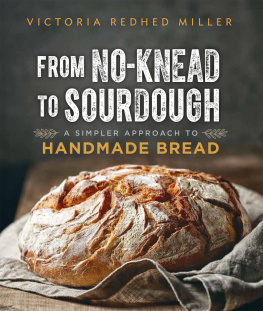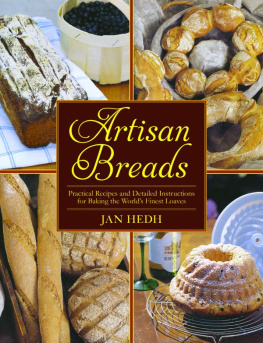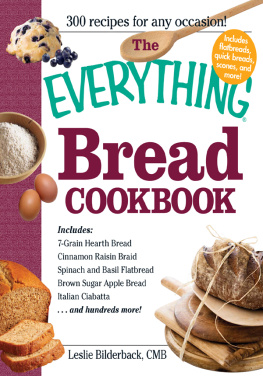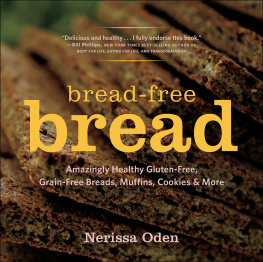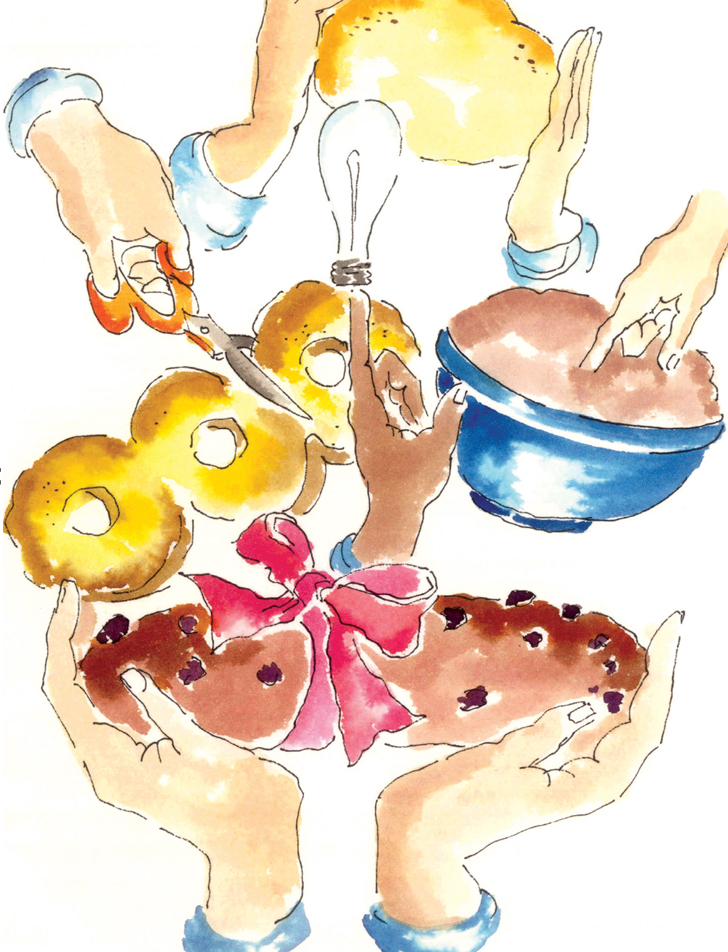All rights reserved. No part of this book may be reproduced or transmitted in any form or by any
means, electronic or mechanical, including photocopying, recording or any information storage and
retrieval system, without permission in writing from the publisher.
Introduction
WHY BAKE BREAD?
I spent my childhood in the company of women who made bread daily, not just for special occasions. My mother, an avid collector of Gourmet magazine, began training me when I was five years old, giving me a little oak work table and a miniature red-handled rolling pin to make cinnamon pinwheels from scraps of her extraordinary, feather-light pie dough. One of my grandmothers, Bessie, taught me how to make beaten biscuits and spoon bread while the other, my Czech grandmother called Bigmama (although she was very little), showed me how to wrap kolache dough around the buttery poppy seed and farmers cheese fillings, which she kept on hand as other people keep salt on the table. By spending as much time as possible in the kitchens of these exceptional and encouraging women, I learned how pleasurable it was to create bread in ones own kitchen.
In my family, bread did not come in packages, just as butter did not come in boxes. Our butter came from the thick layer of cream skimmed off the milk from Bessie, the cow (named after my grandmother?). My grandfather brought the mornings milking to the back porch, and with a giant silver spoon, pulled the heavy top cream aside (into a blue pottery bowl I still own and use for making bread), churned it into butter and sculpted it into a half moon mound, using a cold fork to decorate the butter with cross-hatching. All this just for my grandmothers daily biscuits and country loaves. He knew where his bread was buttered.
Our world was filled with beautiful food on large family tables. Eating was an art and eating alone, unthinkable. The summers apples, peaches, apricots, and berries were made into jams and gleaming, translucent jellies, ready for English muffins, airy biscuits, and country breads. I do not remember any bread that was not made in our kitchen: rye breads, white breads, sourdough biscuits () was made with thick slices of her country white bread dipped in fresh farm eggs, beaten to an amber liquid with cream and cinnamon.
The baking at Thanksgiving and Christmas for the gathering of our extensive clan began at least two weeks before any event. Swedish cookie presses, cornbread and plum pudding moulds, and fancy bread pans were taken out of storage along with vintage tree decorations, all collected over many years. My mother often gave Christmas gifts from her kitchen and the most famous was her chilli pepper cornbread dressing for the turkey. Not only our turkey, but many friends holiday turkeys as well! Along with large quantities of dressing, she would make fruitcakes, sugar cookies, butter cookies, rich little tidbits called sand toks and of course, fresh biscuits, rolls and bread. With memories like these, its no wonder that I ended up with a bakery.
My new career began one summer afternoon when my friend, Myra Cohn Livingston, having returned from a long trip and finding nothing to eat but a frozen Suzanne focaccia, left a message on my phone machine in so many words that if I did not get my breads on the market, I was crazy and then she hung up. Sell my bread? She had to be joking. Would anyone buy it? There was so much competition. I was a novice. I knew very little about running a bread business and even less about making bread for the masses, but when our local market started buying my focaccia and several other markets fell in step, I was suddenly making a thousand loaves a week in my kitchen, and everyone in the household including the cat was covered in flour from early morning to the next days bake!
And mornings were very, very early! Fortunately, my husband joined in, just to help out on a day when I literally could not rise from the bed, and soon I found myself with an able partner. He left a successful screen-writing career of twenty-five years and never looked back. He tells everyone that he had to prove himself for six months before I would succumb to having a partner, but it was really fear on my part that a few focacce would not generate the riches and perks that Hollywood offers. With this in mind, we began to organize the finances (what there were of them), and we both started having daily story meetings about the future of our endeavour.
I remember that one late night, I was sitting alone, thinking to myself, Can I do this? Alone? Its a huge decision. And then, too curious not to, and with no net, I leapt. Ive always been very thankful for that that the unknown called me and I followed, come hell or high water.
It was only after my thumbs and my husbands middle finger gave out from stirring dough so often that it dawned on us to buy a small commercial mixer and to hire our first baker, Leonel Ramos, who was still, after five years, the very able chief of bakers. The thousand loaves, exhaustion and an intractable cat forced us to move out of the house into 215 square metres/2,300 square feet in an industrial area. We bought the same mixer (only bigger), the same ovens (only bigger), and started Buona Forchetta Hand Made Breads which were made the same way they were made at home by eye and by hand.
The recipes are all my own originals, developed over years of trial and error, and I think people respond to them precisely because they are not like other breads. The crusts are lighter, chewier, user-friendly; the crumb is moist and stays fresh longer than most breads; our ingredients are simple and to the point, no froufrou, as I call it. I left it to the customer to add whatever he or she liked to the bread, steering clear of heavily flavoured additions to the dough, such as mixed dried herbs, onions, garlic, cheeses or sun-dried vegetables. These additions often flavour the plainer breads, which bake in the same ovens, and can be the cause of rancidity when breads are not stored well. Cheese, in particular, will go bad in packaged breads or crackers made without preservatives, and I will never use preservatives.
I often think that the way we made our bread at Buona Forchetta must have looked crazy to other bakers (we used no proofers, temperature-controlled equipment, deck ovens or peels), and we regularly broke every rule in the book about baking, yet our clients were loyal year after year, and the process of making handmade breads gave us great pleasure.
No Need to Knead tells you how to make without tears, anxiety, or special equipment the same country loaves, filoncini, focacce and other basic breads I sold at Buona Forchetta Hand Made Breads ) but they never have been my primary focus, especially knowing what I know now.
The majority of the recipes here evolved from going against the grain, so to speak, in order to achieve the moist, wonderfully textured breads I have eaten for years in Italy and France. Once you know the basic dough for a simple bread, you can let your imagination take over. There is very little you cannot put in bread, and I will mention these in individual recipes, but remember that it is best to keep things as simple as possible but no simpler, as Einstein said, and let the natural flavours of the bread emerge. By using your intuition, your own allotment of taste buds, and your skill, you will discover just what works for you and what does not.

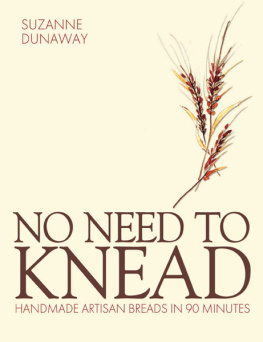
![Ken Forkish - Evolutions in Bread: Artisan Pan Breads and Dutch-Oven Loaves at Home [A baking book]](/uploads/posts/book/323066/thumbs/ken-forkish-evolutions-in-bread-artisan-pan.jpg)
